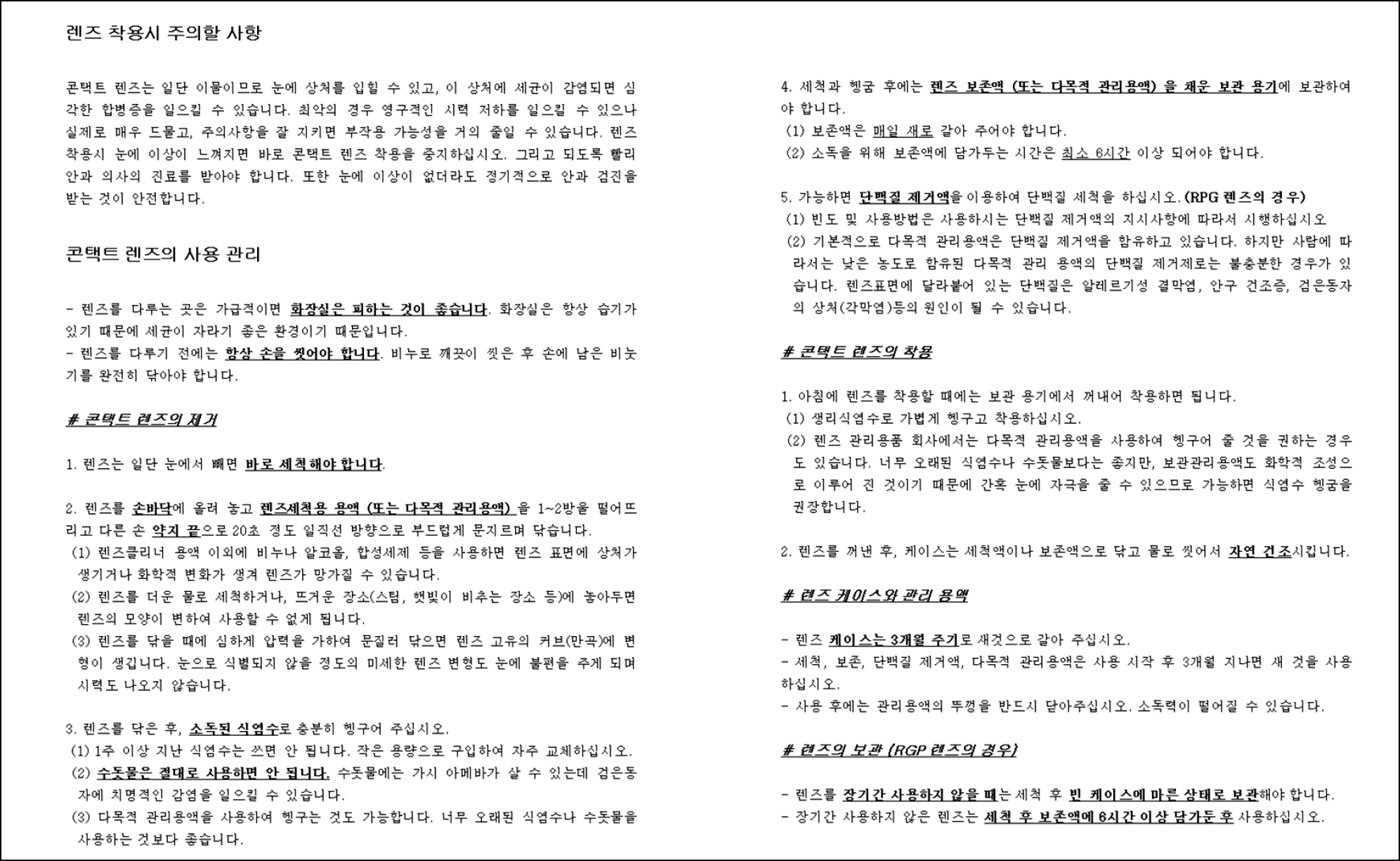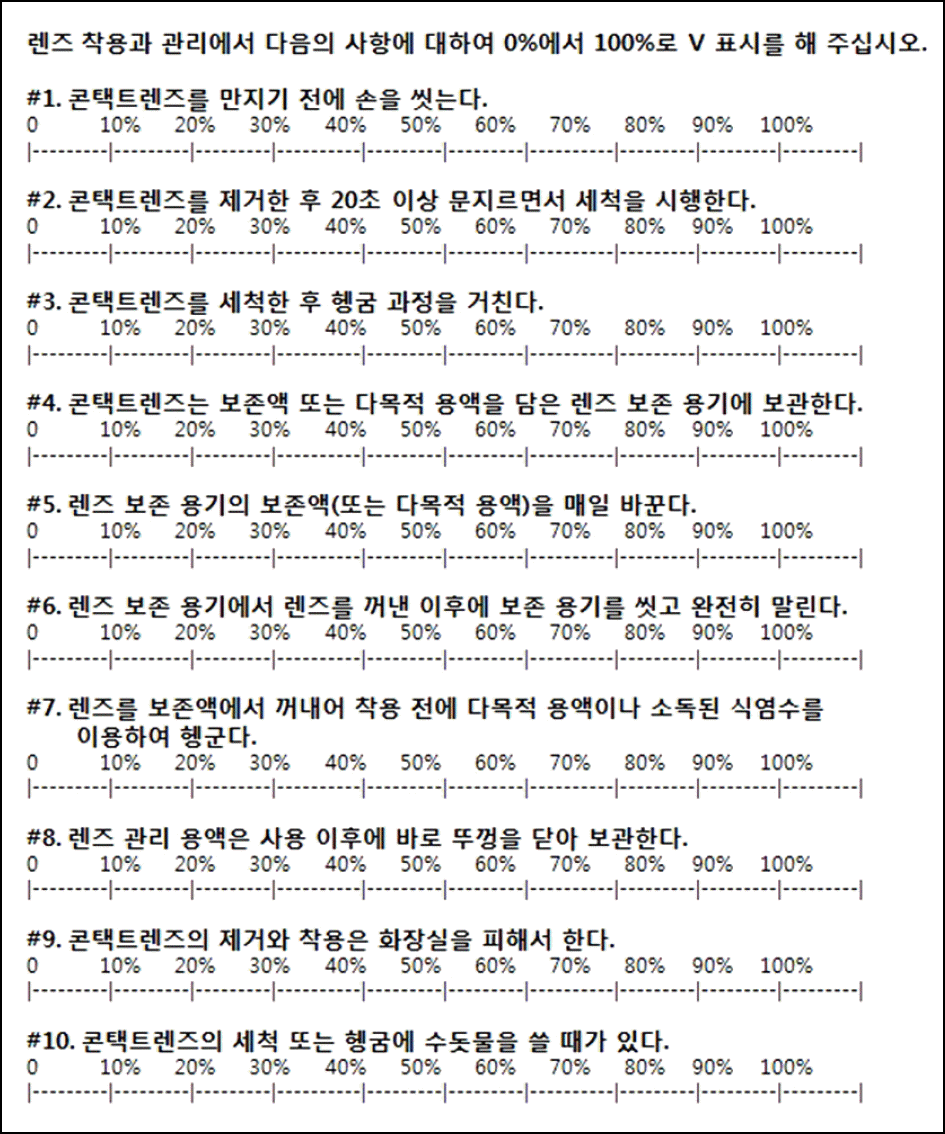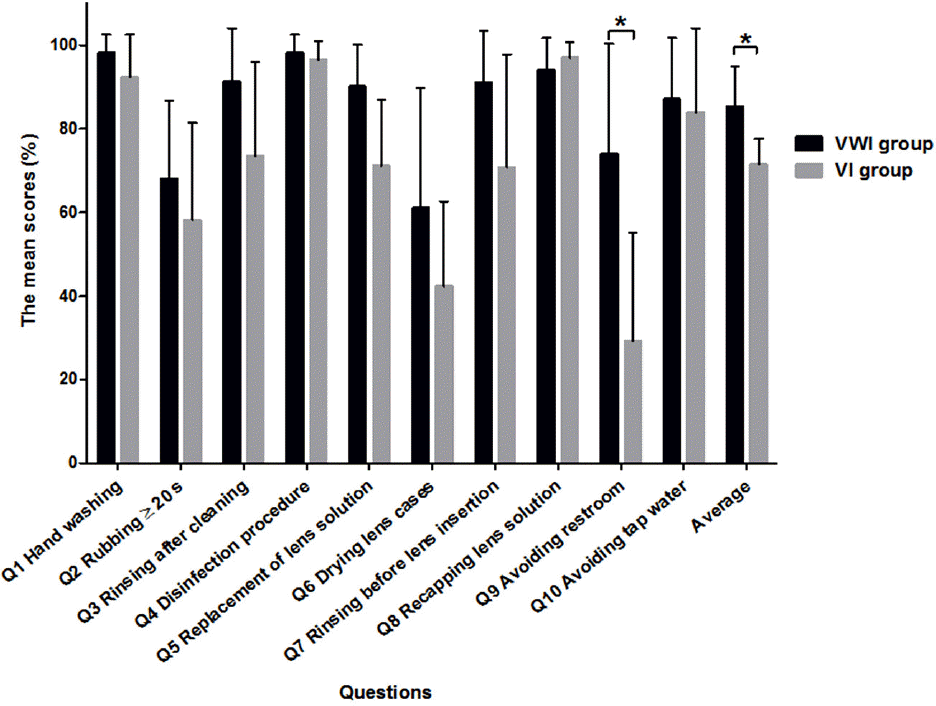Abstract
Purpose
To evaluate the impact of written information on the compliance with proper contact lens (CL) care.
Methods
The patients prescribed CLs by a single ophthalmologist in a clinic from January 2008 to August 2009 were enrolled in the present study. The patients were randomly divided into 2 groups, the verbal and written information (VWI) group and verbal information (VI) group. The patients in the VWI group received verbal and written information on proper CL care and the VI group received the same information only verbally. Patients who were followed-up more than 2 weeks after CL wear were asked 10 questions regarding CL care and statistical analysis was performed for each question on CL care. The Mann Whitney U-test was used for comparison between the 2 groups and Pearson’s test was used for the correlation analyses.
Results
A total of 23 patients were included in this study. Ten patients were assigned to the VWI group, and 13 patients to the VI group. The most desirable score for the CL care was 100 points. The VWI group showed 85.2 ± 13.4 points and the VI group showed 71.5 ± 10.1 points ( p = 0.030, Mann-Whitney U-test). Of the 10 questions, daily replacement of the lens care solution and the use of tap water showed significant correlation with the discomfort induced by the CL and rinsing process before CL insertion showed significant correlation with the CL intolerance ( p = 0.008, p = 0.004 and p = 0.015, respectively, Pearson’s correlation test).
Conclusions
The patients in the written information group showed better compliance for overall CL care. Adding the written in-formation to the verbal explanation can enhance the patient’s compliance with the proper CL care. Enhancing the compliance of CL care with written information can be expected to decrease the complications and improve the comfort of wearing CLs.
References
1. Choi TH, Kim HM, Cha HW. . Research on the current status of contact lenses in Korea. J Korean Ophthalmol Soc. 2004; 45:1833–41.
2. Kim JH, Song JS, Hyon JY. . A survey of contact lens-related complications in Korea: the Korean contact lens study society. J Korean Ophthalmol Soc. 2014; 55:20–31.

3. Singh S, Satani D, Patel A, Vhankade R. Colored cosmetic contact lenses: an unsafe trend in the younger generation. Cornea. 2012; 31:777–9.
4. Lee DK, Choi SK, Song KY. Clinical survey of corneal complica-tions associated with contact lens wear. J Korean Ophthalmol Soc. 1994; 35:895–901.
5. Choi HJ, Yum JH, Lee JH. . Clinical features and compliance in patients with cosmetic contact lens-related complications. J Korean Ophthalmol Soc. 2014; 55:1445–51.

6. Kruse AY, Kjaergard LL, Krogsgaard K. . A randomized trial assessing the impact of written information on outpatients’ knowl-edge about and attitude toward randomized clinical trials. The INFO trial group. Control Clin Trials. 2000; 21:223–40.
7. Butcko V, McMahon TT, Joslin CE, Jones L. Microbial keratitis and the role of rub and rinsing. Eye Contact Lens. 2007; 33((6 Pt 2)):421–3. discussion 424-5.

8. Andrasko G, Ryen K. Corneal staining and comfort observed with traditional and silicone hydrogel lenses and multipurpose solution combinations. Optometry. 2008; 79:444–54.

9. Carnt NA, Evans VE, Naduvilath TJ. . Contact lens-related ad-verse events and the silicone hydrogel lenses and daily wear care system used. Arch Ophthalmol. 2009; 127:1616–23.

10. Lebow KA, Schachet JL. Evaluation of corneal staining and patient preference with use of three multi-purpose solutions and two brands of soft contact lenses. Eye Contact Lens. 2003; 29:213–20.

Figure 1.
The written information for the contact lens care. It contains where to clean the lenses, how to scrub the lenses, and how to care the lenses and their cases.

Figure 2.
The questionnaire of the contact lens care. It con-tains the preparation and process for the care of contact lenses and the management of lens storage solution and cases. The re-sults of Q10 was analyzed in reverse, as it scores negatively for good compliance.

Figure 3.
The mean score (%) of each question and total for the contact lens care. Asterisks (*) indicates significant differ-ence between the Verbal and written information group (VWI group) and the Verbal information group (VI group) for the place of lens care and the average score ( p-value < 0.05 by Mann-Whitney U-test). Error bars indicate 95% confidence interval of means. s = seconds.

Table 1.
Demographic characteristics of subjects of both groups
Table 2.
The correlation between the discomfort of contact lens and each question
Table 3.
The correlation between the contact lens intolerance and each question




 PDF
PDF ePub
ePub Citation
Citation Print
Print


 XML Download
XML Download